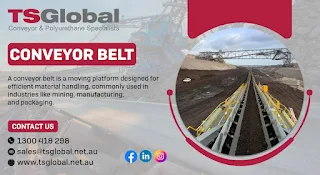In heavy industries like mining, quarrying, and agriculture, conveyor systems are essential for material handling. Yet, to maintain consistent productivity and minimize maintenance issues, two key components stand out—conveyor belt scraper installation and a conveyor belt tracking system. In Australia, TS Global has become a trusted name in providing these critical solutions, ensuring industrial efficiency and operational safety.
The Importance of Conveyor Belt Scraper Installation
Carryback is a common problem in conveyor operations. It causes material buildup on pulleys and rollers, which leads to system wear, misalignment, and unexpected shutdowns. This is where conveyor belt scraper installation becomes essential.
TS Global specializes in supplying and installing high-performance conveyor belt scrapers that effectively clean the belt without damaging its surface. Their scrapers are engineered to work in all types of environments, handling materials from fine dust to heavy ores. Professional installation by TS Global ensures proper blade positioning, correct tension, and long-lasting cleaning efficiency.
With correct scraper installation, industries can reduce spillage, improve system hygiene, and extend the lifespan of conveyor belts—saving both time and maintenance costs.
Precision Conveyor Belt Tracking System
Another crucial part of a well-functioning conveyor system is accurate belt tracking. Misaligned belts cause uneven wear, material spillage, and safety risks. TS Global offers a conveyor belt tracking system designed to keep belts centered and properly aligned throughout operation.
These systems are vital for reducing downtime and improving equipment longevity. TS Global's belt tracking solutions are built with high-quality materials and use advanced design to detect and correct belt movement before it causes damage.
Installed by trained technicians, the belt tracking system enhances overall performance, reduces material loss, and prevents unexpected breakdowns. This is especially valuable in Australia’s rugged industrial environments where reliability is non-negotiable.
Why Choose TS Global?
As a leader in conveyor components and services, TS Global has earned its reputation through innovation, reliability, and customer-focused solutions. By offering expert conveyor belt scraper installation and efficient belt tracking systems, TS Global supports Australian industries in achieving peak operational performance.
From system assessments to ongoing technical support, TS Global ensures its clients receive not just products—but complete, results-driven solutions.
Conclusion
Efficient material handling depends on a clean and accurately aligned conveyor system. With professional conveyor belt scraper installation and advanced conveyor belt tracking systems, TS Global helps industries across Australia optimize performance, minimize risks, and extend the life of their equipment.
If you’re looking for proven solutions to improve conveyor safety and efficiency, TS Global is the trusted name to rely on in Australia’s demanding industrial landscape.



.jpg)


